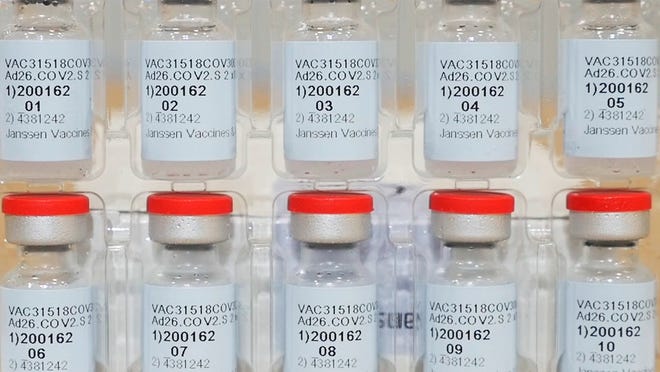
A government advisory committee is likely to give a thumbs up Friday to a third COVID-19 vaccine, paving the way to increased supply of the much-in-demand vaccines.
The new vaccine, from drugmaker Johnson & Johnson, offers a few advantages over the two that have been administered to 45 million Americans since mid-December, although it may be somewhat less effective.
The J&J vaccine requires only one shot; the others, from Pfizer-BioNTech and Moderna, need two. It can be kept refrigerated rather than frozen for longer, making it easier to distribute through doctors' offices and rural outposts. And it may cause fewer side effects.
The advisory panel, called the Vaccines and Related Biological Products Advisory Committee, is likely at the end of an all-day meeting to recommend the shot for use in adults. An emergency use authorization from the acting commissioner of the Food and Drug Administration is anticipated to follow within days.
Most people will not have a say in which vaccine they get. Allocation decisions are made by individual states, which have generally provided only one type of vaccine at a time to each vaccination center.
Public health officials say it doesn't matter which vaccine someone receives.
A third vaccine is "nothing but good news," Anthony Fauci, America's top infectious disease doctor, told NBC's "Today" show early Thursday. "To have two is fine. To have three is absolutely better.”

Johnson & Johnson said it will make 20 million doses of the vaccine available in March and an additional 80 million by the end of June to fulfill a contractual agreement with the government. Taxpayers paid nearly $500 million to help develop the vaccine and $1 billion to produce and deliver these 100 million doses.
The government prepaid for the vaccines, and insurance companies or the government are likely to pick up the cost of administering shots, so no one should have to pay out of pocket for protection.
As new variants circulate that might make vaccines less effective, it's important to get as many people vaccinated as quickly as possible, Fauci and others have said, to reduce transmission before more dangerous viral variants can spread or develop.
Vaccines from Moderna and Pfizer-BioNTech were shown in large clinical trials last fall to be more than 94% effective, a result confirmed by a real-world study in Israel.
The J&J vaccine was found in its large trial to be 72% effective in the USA but less effective in South Africa and Latin America, where variants circulated.
Some people will be more comfortable with the J&J vaccine because it is based on a technology with a longer track record or requires only one dreaded shot; others will balk at a vaccine that may be less effective – but they shouldn't, public health experts told USA TODAY.
All the COVID-19 vaccines have been shown to prevent serious disease and death.
"People should get vaccinated with whatever vaccine they can get of the ones that FDA authorizes," said Dr. Jesse Goodman, professor of medicine and infectious diseases at Georgetown University Medical Center.
The J&J vaccine is more effective than the annual flu shot and will help rein in the pandemic, said Dr. Eric Schneider, senior vice president for policy and research at the Commonwealth Fund, a private philanthropy that studies health care policy and practice.
"Anything that slows transmission for even a portion of the population is going to be a great addition," Schneider said.
The less restrictive storage requirements will enable the J&J vaccine to be distributed by primary care doctors' offices, he said, although it's not clear whether these offices can handle vaccinations after the disastrous year they had financially in 2020, when patients stayed away and billings dropped substantially.
The fact that the Moderna and Pfizer-BioNTech vaccines are "historically effective," Schneider said, shouldn't take away from the somewhat lower but still excellent effectiveness of the J&J vaccine.
"If we didn't already have Moderna and Pfizer with 95% efficacy, we'd be jumping up and down about J&J," said Dr. Thomas Balcezak, chief clinical officer for Yale New Haven Health. "Somehow now that we've got a 95% effective vaccine … we seem to be cooling on this vaccine that a year ago we would have been thrilled to have."
J&J uses different vaccine technology
All the vaccines are equally effective where it counts, said Anna Legreid Dopp, senior director of clinical guidelines and quality improvement at the American Society of Health-System Pharmacists.
"They're reducing symptomatic severe disease that leads to hospitalization and death," she said. "It's those two things that will reduce the societal burden overall and the strain on our health care system on a whole."
She said pharmacists will be ready to handle any vaccine, but J&J's is based on a technology that pharmacists have used, so they're likely to be more familiar with it than they were with the Pfizer-BioNTech and Moderna vaccines.
The first two vaccines are based on a so-called mRNA technology, and are virtually indistinguishable, with similar safety and effectiveness profiles. They use the body's natural protein manufacturing system to deliver instructions to cells to make the spike protein on the outside of the SARS-CoV-2 virus particles.
Once the immune system is taught to recognize this spike protein, it will attack upon infection with SARS-CoV-2.

The J&J vaccine instead uses a harmless virus called adenovirus 26 to deliver the spike protein to cells, training the immune system.
No one in the trial suffered a severe enough allergic reaction to require epinephrine, though one man did endure extended hives and discomfort.
Although all the vaccines appear to be very safe, side effects seemed to be milder and less widespread with the J&J vaccine than with the other two, Dr. Colleen Kraft, associate chief medical officer for Emory University Hospital, said Thursday in a call with reporters.
"The J&J vaccine is considered a little bit less reactogenic, or stimulating of the immune system, which kind of goes along maybe with how protective it is," she said.
The Pfizer-BioNTech and Moderna vaccines have triggered serious allergic reactions in two to six vaccine recipients per million doses delivered. Those reactions turned up once the vaccines were given to millions of people, not during their large clinical trials.
All the vaccines can cause sore arms, muscle aches, headaches, fever, chills and other symptoms that usually pass within a day or two.
The COVID-19 vaccines are not made with eggs, unlike many flu vaccines, so they are considered safe for people with egg allergies, though other ingredients may trigger allergic responses.
Will vaccine distribution change?
Some have wondered whether the new vaccine, with its different characteristics, should be used more strategically rather than just adding it to the pool of available vaccines.
Because it doesn't need to be stored at freezer temperature, as the other two largely do, it may make sense to send the J&J vaccine to rural communities and small practices that may not have pharmaceutical-grade freezers, said Julie Morita, executive vice president of the Robert Wood Johnson Foundation, and a member of President Joe Biden's transition team.
An advisory committee to the Centers for Disease Control and Prevention, scheduled to meet Sunday and Monday, may take up the idea of targeting distribution to particular populations, she noted.
Morita said she hopes increasing the overall supply of the vaccine will enable a more equitable distribution of shots.
Yale New Haven Health's Balcezak said he sees a third vaccine as "one more variable that's going to create one more potential for inequity."
In some ways, he said, it makes sense to allocate the J&J vaccine to inner city neighborhoods, where it's proving particularly difficult to deliver one shot, no less two.
"The challenge with that is that's going to inherently bias them to getting this less efficacious vaccine," he said. The country needs to "figure out how we don't allow this to become yet another way health disparities impact our Black and brown communities or our inner cities."
Goodman, co-chair of the COVID-19 Vaccine Analysis Team, a group of experts, said there's not a lot of information about how the J&J vaccine will perform in older people. Some have suggested that it might make sense to target the J&J vaccine to younger people, who are less likely to suffer severe disease or die from COVID-19.
"It's still early to compare one vaccine to another," Goodman said Wednesday on a call with reporters.
He would like to see major national studies of how authorized vaccines perform in the real world to better understand whether some vaccines are better suited to certain populations.
"That's how we're going to uncover if these differences are real," he said.
Contact Karen Weintraub at kweintraub@usatoday.
Health and patient safety coverage at USA TODAY is made possible in part by a grant from the Masimo Foundation for Ethics, Innovation and Competition in Healthcare. The Masimo Foundation does not provide editorial input.
Source link









